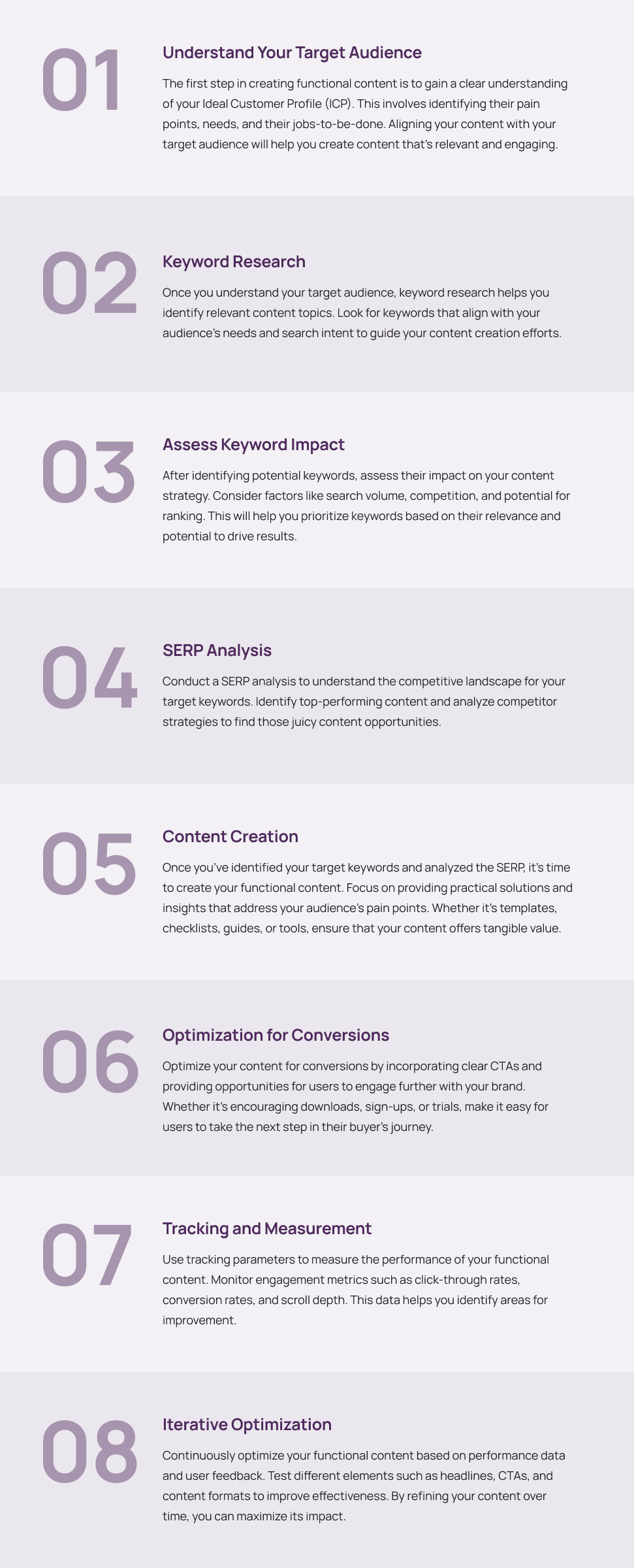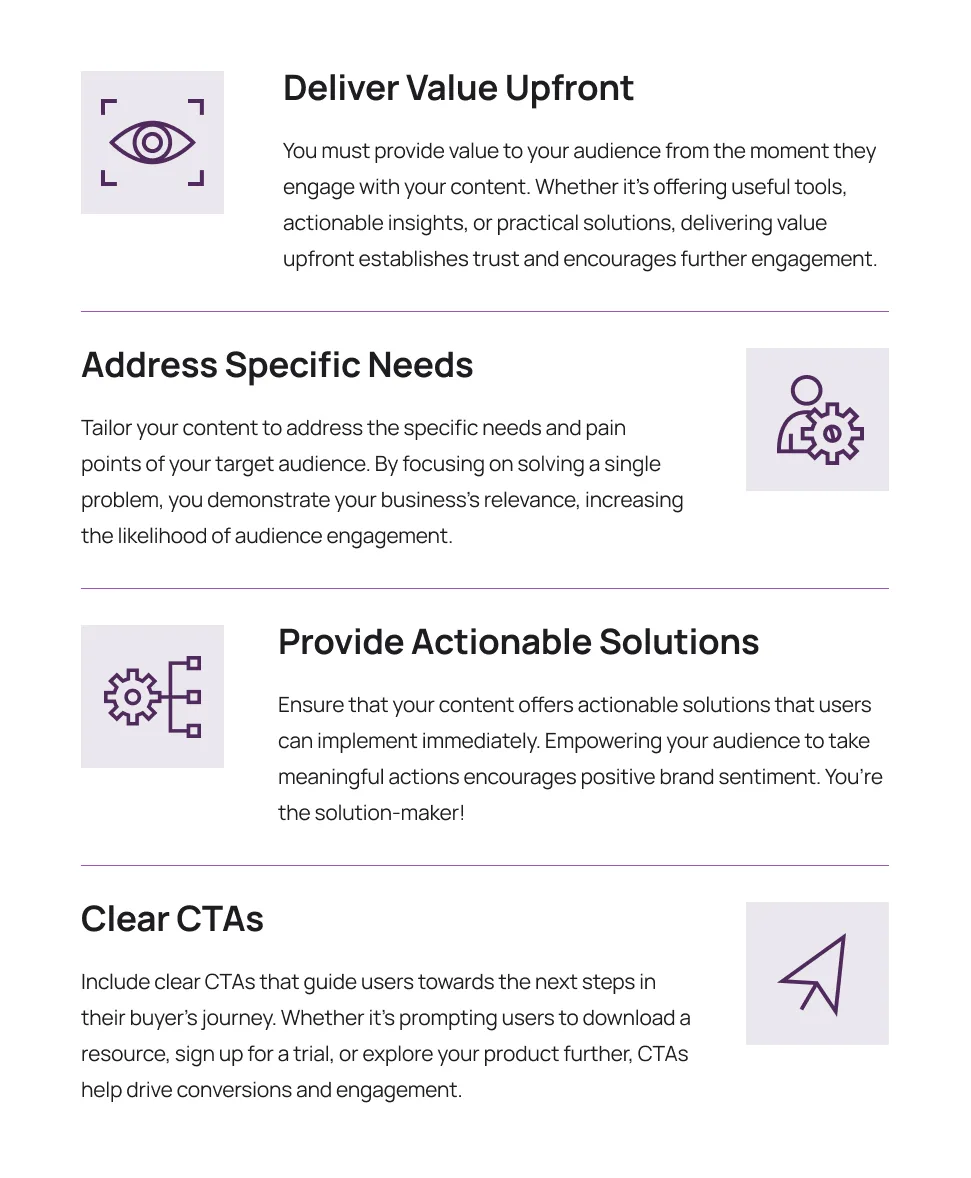Understanding Functional Content
Functional content is a strategic approach to content creation that bridges the gap between what your customers are looking for and what your business can offer them.
It’s about creating scalable, consistent content with clear calls-to-action (CTAs) that guide customers towards your product or service. Functional content is designed to meet the needs of your ideal customer personas (ICP) by providing practical solutions and insights that make their lives easier.
You’ll find that functional content can take various forms, such as templates, checklists, and worksheets, tailored to address your customers’ jobs-to-be-done. By providing valuable content that aligns with the informational intent of your audience, functional content encourages users to share their contact information in exchange for the insights and solutions your business offers. Win-win!
In essence, functional content helps businesses attract and engage with potential customers by delivering content that addresses their specific needs.
The Impact of Functional Content on Business
The impact of functional content goes beyond just collecting contact information. While building your customer pipeline is crucial, functional content also plays a huge role in promoting brand awareness.
When you create content that genuinely helps your ICP, users are more likely to share it online. When they share it online, this not only expands the reach of the content but also attracts new potential customers who are in the market for similar solutions.
Your key to success here is to address users’ pain points directly. This showcases your expertise, which will lead to more qualified leads and customers.
Additionally, by consistently delivering content that addresses pain points and provides solutions, you position your business as trusted sources of information, which helps build trust and loyalty with your customers and potential buyers.
The impact of functional content on businesses is huge. It drives lead generation, enhances your brand, positions you as a thought leader, and fosters customer trust and loyalty. If you’re prioritizing customer-centric approaches in 2024, you should be testing the creation of functional content.
Steps to Develop Functional Content
When developing functional content, there are a few key steps you need to include to make it successful:

By following these steps, you can develop functional content that resonates with your target audience, drives engagement, and ultimately helps you create more customers.
Key Aspects of Functional Content
Here are the are must-haves for an effective content strategy:

Incorporate these key aspects into your functional content, so you can create compelling and valuable experiences for your audience. They’ll become fans of your brand in no time!
Common Mistakes in Functional Content Creation
If you avoid these common mistakes, you will achieve the right results with your functional content.
Avoid these potential pitfalls:
- Failing to deliver value upfront. One of the biggest mistakes you can make is not delivering value to your audience from the start. If your content fails to provide immediate utility or relevance, users will skip it.
- Overemphasis on product promotion. Don’t focus too heavily on self-promotion. In this stage of their journey, users are seeking content that addresses their specific needs rather than being bombarded with sales pitches. You must strike a balance between offering genuine solutions to pain points, and saving self-promotion for later in the buyer’s journey.
- Neglecting audience research. If you fail at understanding your target audience and their needs, your content will miss the mark. Before you create content, make sure you understand their pain points, preferences, and behaviors. If you align the content with your audience’s needs, you’ll drive more engagement.
- Lack of optimization. Ensure that your functional content is optimized for search engines by conducting keyword research. Incorporate those keywords into your content so it’s easier to search for.
Steer clear of these common mistakes and focus on delivering value upfront. This will allow you to create functional content that resonates with your audience and drives engagement.
Measuring Performance and Optimization
Here’s how to measure performance and optimize your functional content to maximize its effectiveness:
- Track engagement metrics. Monitor key engagement metrics such as click-through rates, time spent on page, bounce rates, and social shares to gauge how well your content resonates with your audience. These metrics help you identify which pieces of content are performing well and which need optimizing.
- Analyze conversion rates. Use conversion rates to understand how effective your content is at guiding users through the buyer’s journey. Track conversion metrics such as form submissions to determine its impact.
- Monitor keyword rankings. Keep a close eye on the rankings of keywords in your functional content to assess its visibility and discoverability in search engine results. Tools like Google Analytics and SEMrush can help you track keyword rankings and identify opportunities for optimization.
- A/B testing. Experiment with A/B testing to determine which elements resonate best with your audience. Test variations in headlines, visuals, calls-to-action, and content formats to optimize performance.
- Iterate. Continuously iterate and optimize your functional content based on performance data. Update and refine your content to ensure its relevance and effectiveness over time.
Use these measurement and optimization strategies in your functional content to better meet the needs and preferences of your audience and, ultimately, crush your 2024 marketing goals.
Directive’s Success with Functional Content
To tackle a challenge faced by one of our clients, we implemented a functional content strategy, and the results were impressive.
The client wanted to drive more users into their free trial, but their email templates were underperforming. Despite existing templates, they struggled to optimize them effectively.
To address this, we decided to create 17 high-quality email templates and corresponding website pages. Our strategy was to optimize these pages to attract organic traffic and guide users seamlessly into the free trial experience.
After doing thorough keyword research, we identified a few templates we found online to help inform our approach. Once we knew what templates we liked, we utilized AI tools to expedite content creation before taking it over ourselves.
Once the content and pages were created, we optimized each page from an SEO standpoint to enhance search visibility.
Despite the large scale of the work, we completed the project within 3 to 4 weeks. Then came the fun of seeing if what we created worked. expectations.
The results were incredible. Within three months of launching the optimized pages, our client was elated at growth results such as:
- Ranked for over 500 keywords
- Attracted over 8000 new users to the site
- Achieved an 88% engagement rate
- Generated over 300 conversions
The awesome results proved that our functional content strategy was highly effective in driving organic traffic, engagement, and conversions. Huge win for the client and for us!
Wrapping up
Directive’s success with functional content shows the importance of understanding your ICP’s needs, delivering valuable insights, and providing actionable solutions. By using a strategic approach to content creation and focusing on delivering value first, businesses like yours can achieve big results in 2024.
-
evan
Did you enjoy this article?
Share it with someone!
